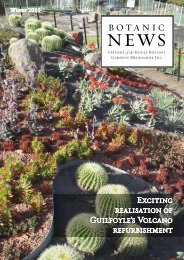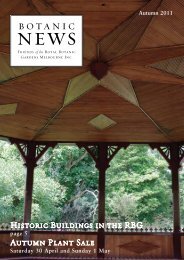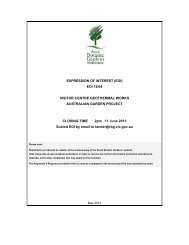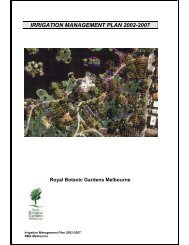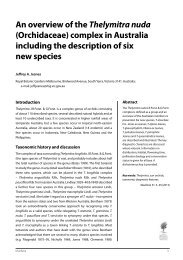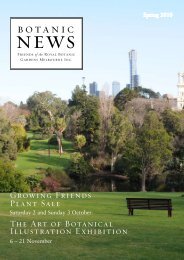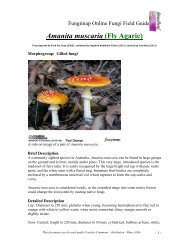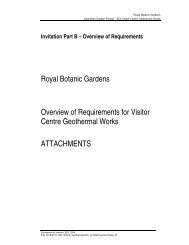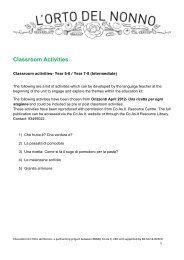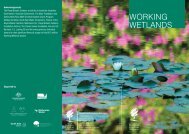Annual Report 2010-2011 (PDF - 2.47 mb) - Royal Botanic Gardens ...
Annual Report 2010-2011 (PDF - 2.47 mb) - Royal Botanic Gardens ...
Annual Report 2010-2011 (PDF - 2.47 mb) - Royal Botanic Gardens ...
You also want an ePaper? Increase the reach of your titles
YUMPU automatically turns print PDFs into web optimized ePapers that Google loves.
Contents<br />
OUR achievements – Strategic Priority 2A<br />
Business Plan specific outcomes<br />
(and associated Corporate Plan actions)<br />
Progress against specific outcomes and actions<br />
1<br />
Pest is a generic term<br />
used internationally to<br />
denote plant-deleterious<br />
organisms such as<br />
insects, fungi,<br />
nematodes, viruses, etc.<br />
Specific Outcome 21<br />
(Relating to Corporate Plan Action 18)<br />
Expand horticultural research programs which<br />
demonstrate sustainable practices which can be<br />
applied as adaptations to climate change by:<br />
a. continuing to undertake scientific research in<br />
landscape water use in partnership with The<br />
University of Melbourne and Sentek Pty Ltd.<br />
This will be achieved through the use of soil<br />
moisture sensing technology and comparison<br />
with existing irrigation scheduling techniques<br />
b. continuing to undertake scientific research to<br />
monitor RBG Melbourne rainfall and vegetation<br />
throughfall (rain amount reaching ground<br />
surface) in partnership with the School of<br />
Geographic and Environmental Sciences<br />
(SGES), Monash University<br />
c. completing and implementing the <strong>Royal</strong> <strong>Botanic</strong><br />
<strong>Gardens</strong> Biosecurity Plan, a framework for the<br />
strategic management of biosecurity, in order to<br />
reduce the risk of exotic pest 1 incursions and to<br />
adopt a common approach to border quarantine<br />
for the <strong>Royal</strong> <strong>Botanic</strong> <strong>Gardens</strong><br />
Research programs and collaborations continued<br />
into sustainable horticultural practices to support<br />
the <strong>Royal</strong> <strong>Botanic</strong> <strong>Gardens</strong>’ endeavours to meet<br />
the challenge of climate change. These included:<br />
a. Gathering soil moisture data from over 80<br />
locations across RBG Melbourne for the purpose<br />
of fine tuning irrigation scheduling. Due to<br />
improved rainfall in <strong>2010</strong>–11, measurements<br />
showed a marked recharge of deep subsoil<br />
moisture and re-use by trees for probably the first<br />
time after a decade of drought conditions. The<br />
project team developed an innovative concept of<br />
‘banking’ water – Subsoil Water Storage and<br />
Recovery (SWSR) – in the subsoil to improve the<br />
health of trees in drought and maximise water<br />
efficiency. This concept is expected to be more<br />
broadly implemented to maximise non-potable<br />
water use as part of Working Wetlands Part B.<br />
(See also Goal 3, Specific Outcome 42a.)<br />
b. Research was initiated into relative humidity and<br />
temperatures across four sites at RBG Melbourne<br />
using data-logging. The study helped identify<br />
more suitable microclimates for specific plants<br />
in the Living Collections and improved the<br />
efficiency of irrigation cooling systems;<br />
this work will continue into <strong>2011</strong>–12.<br />
A paper entitled ‘Interception rates and<br />
processes on vegetation in a major urban area:<br />
metropolitan Melbourne, Australia’ was presented<br />
by SGES at the European Geosciences Union<br />
General Asse<strong>mb</strong>ly, Vienna, in May <strong>2011</strong>. The<br />
study focussed on RBG Melbourne as an urban<br />
site for the research. To date, the findings of<br />
rainfall losses from canopy interception have<br />
implications for water management planning<br />
across the <strong>Royal</strong> <strong>Botanic</strong> <strong>Gardens</strong> and for urban<br />
environments more generally.<br />
c. The <strong>Royal</strong> <strong>Botanic</strong> <strong>Gardens</strong>’ Biosecurity Policy<br />
was developed and approved and a Biosecurity<br />
Procedure drafted. (See also Goal 3, Specific<br />
Outcome 42c.)<br />
<strong>Royal</strong> <strong>Botanic</strong> <strong>Gardens</strong> Board Victoria <strong>Annual</strong> <strong>Report</strong> <strong>2010</strong>–11 page 61




